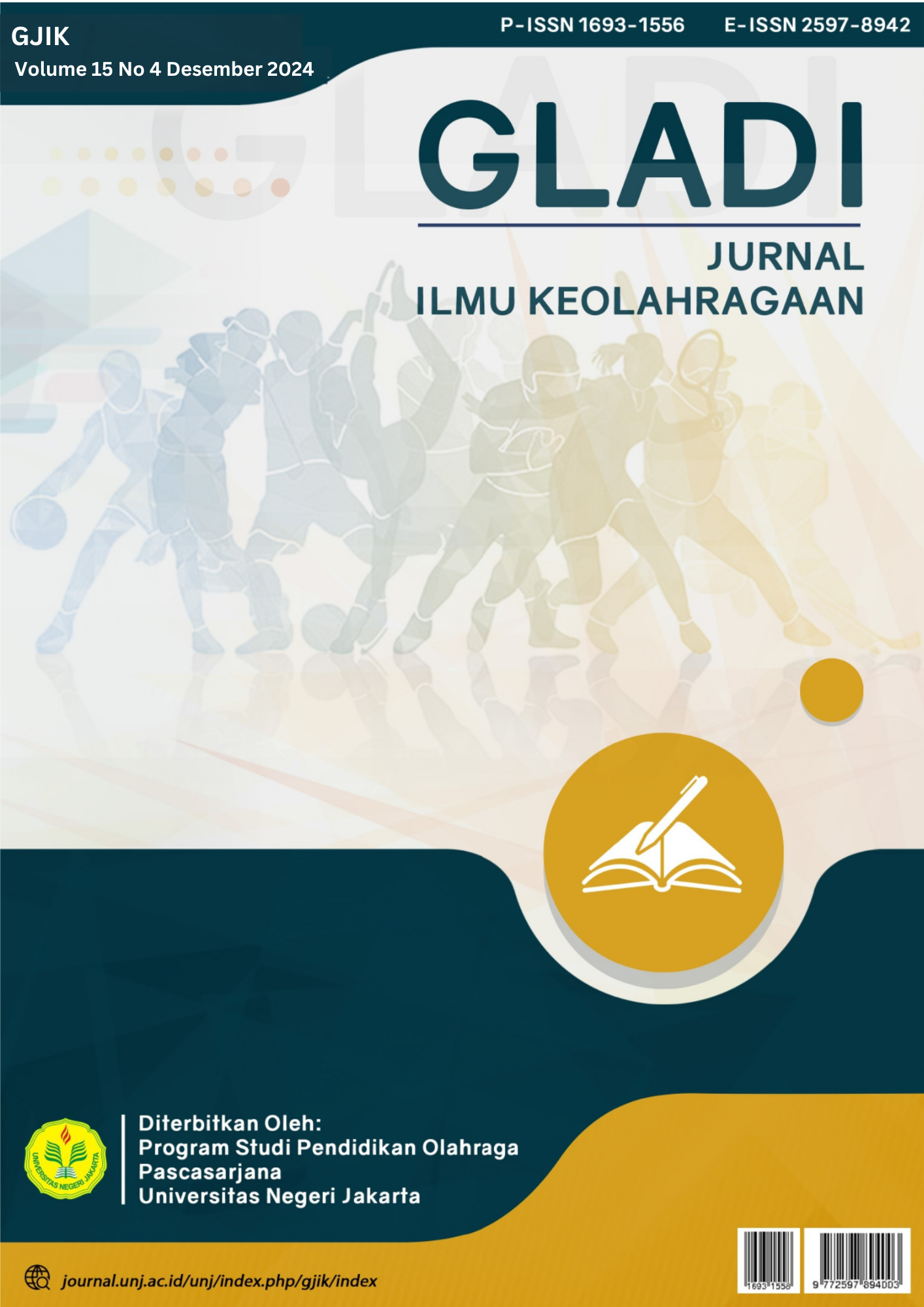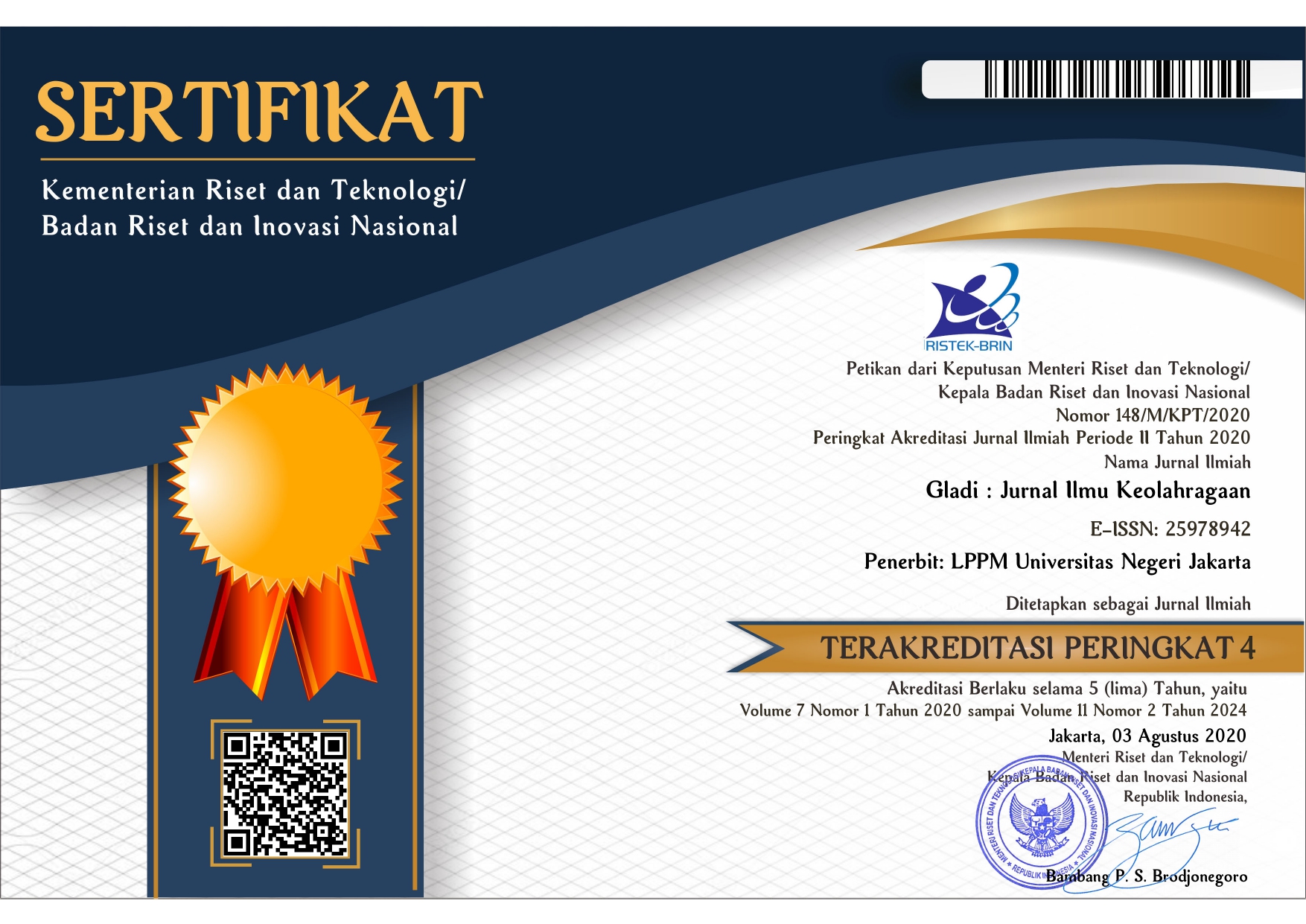OPTIMISING LOCOMOTOR BASIC MOTION LEARNING OUTCOMES THROUGH THE "MOTION CIRCUIT" PLAYING MODEL FOR GRADE 3 STUDENTS
DOI:
https://doi.org/10.21009/GJIK.154.12Keywords:
Basic locomotor skills, Elementary students, Engagement in learning, Educational innovationAbstract
Developing basic locomotor skills is crucial for elementary students, yet conventional teaching methods at SDN 1 Boyolali have led to low engagement and suboptimal outcomes. This study explores the "Motion Circuit" play-based model as a solution, using fun and interactive activities to create a more engaging learning environment for locomotor skills. Through Classroom Action Research (CAR), the model is applied in planning, action, observation, and reflection cycles, allowing for real-time assessment and refinement of teaching strategies. CAR’s structured, collaborative approach supports skill acquisition and effective learning, which the "Motion Circuit" model aims to achieve at SDN 1 Boyolali. Over two research cycles, results showed a significant increase in competencies across affective, cognitive, and psychomotor domains, with outcomes of 100% affective, 82.86% cognitive, and 97.14% psychomotor benchmarks achieved by Cycle II. This engaging model proved highly effective for improving student motivation, comprehension, and physical skills, making it a valuable alternative to traditional Physical Education methods by promoting skill acquisition and a positive learning attitude.
Downloads
References
Annisa Ibnus, P. (2020). Implementation of the Physical Education, Sport and Health Learning Process Based on the 2013 Curriculum in Elementary Schools of Padang. 1st International Conference of Physical Education, 4–7. https://doi.org/https://doi.org/10.2991/assehr.k.200805.002
Ardanari, P., Nurhasan, N., & Tuasikal, A. S. (2023). Motor Skills Increase In The Learning Model Of Circuit Games. COMPETITOR: Jurnal Pendidikan Kepelatihan Olahraga, 15(2), 298. https://doi.org/10.26858/cjpko.v15i2.46928
Armstrong, T., & Sutherland, D. (2020). Let Them Play! A Call for Play-Based Instruction in Pre-K Physical Education. In Journal of Physical Education, Recreation and Dance (Vol. 91, Issue 8, pp. 5–7). Routledge. https://doi.org/10.1080/07303084.2020.1800340
Arufe-Giráldez, V., Sanmiguel-Rodríguez, A., Ramos-Álvarez, O., & Navarro-Patón, R. (2023). News of the Pedagogical Models in Physical Education—A Quick Review. In International Journal of Environmental Research and Public Health (Vol. 20, Issue 3). MDPI. https://doi.org/10.3390/ijerph20032586
Asnawati, S., Kusuma Dewi, I. L., Nopriana, T., & Firmasari, S. (2021). Assistance in preparing Classroom Action Research articles and publications in reputable national journals. Abdimas: Jurnal Pengabdian Masyarakat Universitas Merdeka Malang, 6(4), 629–639. https://doi.org/10.26905/abdimas.v6i4.5617
Cavanaugh, L. (2016). Learning Links: Reflex Inhibition and Literacy Skills Enhanced for Under-Achieving Elementary Students. Literacy Information and Computer Education Journal, 6(2), 2309–2315. https://doi.org/https://doi.org/10.20533/licej.2040.2589.2016.0305
Donnelly, F. E. C., & Mueller, S. S. (2018). The Learning Connection: The Role of Movement-skill Learning in Teaching Developmental Games. Journal of Physical Education, Recreation and Dance, 89(5), 30–36. https://doi.org/10.1080/07303084.2018.1440267
Gilang, F., Pradana, A., & Juniarisca, D. L. (2020). The Development of MODEREN to Increase Gross Motor Skills of Students with Mild Mental Retardation. Proceedings of the 4th International Conference on Sport Science, Health, and Physical Education, 24–26. https://doi.org/https://doi.org/10.2991/ahsr.k.200214.007
Handayani, G. (2020). Development of Motor Learning Model Based on Game and Fun Activities. Proceedings of the 1st Progress in Social Science, Humanities and Education Research Symposium, 398–401. https://doi.org/https://doi.org/10.2991/assehr.k.200824.095
Hernawan, H., Sukarya, Y., & Solahuddin, S. (2019). Locomotor basic motion learning model based on traditional game for basic school students. Journal of Physics: Conference Series, 1318(1). https://doi.org/10.1088/1742-6596/1318/1/012047
Humphries, C., Lovdahl, P., & Ashy, M. (2002). Elementary Physical Education and the National Standards. Journal of Physical Education, Recreation & Dance, 73(5), 42–45. https://doi.org/10.1080/07303084.2002.10607808
Ilgaz, H., Hassinger-Das, B., Hirsh-Pasek, K., & Golinkoff, R. M. (2018). Making the Case for Playful Learning. In Springer International Handbooks of Education: Vol. Part F1626 (pp. 1245–1263). Springer Nature. https://doi.org/10.1007/978-94-024-0927-7_64
Jariono, G., Nugroho, H., Hermawan, I., Fachrezzy, F., & Maslikah, U. (2021). The Effect of Circuit Learning on Improving The Physical Fitness of Elementary School Students. International Journal of Educational Research & Social Sciences, 2(1), 59–68. https://doi.org/https://doi.org/10.51601/ijersc.v2i1.22
Nesbitt, D., & Bullard, D. (2021). Understanding Fundamental Movement Skills By. Strategies, 34(3), 5–10. https://doi.org/10.1080/08924562.2021.1896909
O’Shea, R., Jones, M., & Lightfoot, K. (2020). Examining Conductive Education: Linking Science, Theory, and Intervention. Archives of Rehabilitation Research and Clinical Translation, 2(4). https://doi.org/10.1016/j.arrct.2020.100077
Ramadan, G., Mulyana, N., Iskandar, D., Juniarti, Y., & Hardiyanti, W. E. (2020). Physical Education for Early Childhood: The Development of Students’ Motor in Athletics Basic Motion. Proceedings of the 4th International Conference on Sport Science, Health, and Physical Education, 83–86. https://doi.org/https://doi.org/10.2991/ahsr.k.200214.023
Reddy, L. A., Dudek, C. M., & Lekwa, A. (2017). Classroom Strategies Coaching Model: Integration of Formative Assessment and Instructional Coaching. Theory into Practice, 56(1), 46–55. https://doi.org/10.1080/00405841.2016.1241944
Setiawan, A., Yudiana, Y., Ugelta, S., Oktriani, S., Budi, D. R., & Listiandi, A. D. (2020). Hasil Belajar Pendidikan Jasmani dan Olahraga Siswa Sekolah Dasar: Pengaruh Keterampilan Motorik (Tinggi) dan Model Pembelajaran (Kooperatif). TEGAR: Journal of Teaching Physical Education in Elementary School, 3(2), 59–65. https://doi.org/10.17509/tegar.v3i2.24513
Siregar, N. M., Sari, E. F. N., Budiningsih, M., & Zulham. (2021). The basic learning model of traditional motion based games for early childhood (5-6) years. International Journal of Human Movement and Sports Sciences, 9(1), 81–88. https://doi.org/10.13189/saj.2021.090111
Wang, Q. (2019). Developing a Technology-supported Learning Model for Elementary Education Level. Mimbar Sekolah Dasar, 6(1), 141. https://doi.org/10.17509/mimbar-sd.v6i1.15901
Yusron, A., Irawati, J., Teguh Setiawan Wibowo, Husen, & Sudadi. (2023). The Impact of Classroom Action Research (CAR) and Innovation on Teacher Professionalism: an Intervention of Competence. Jurnal Informatika Ekonomi Bisnis, 563–570. https://doi.org/10.37034/infeb.v5i2.594
Downloads
Published
How to Cite
Issue
Section
License
Copyright (c) 2024 Waluyo, Djoko Nugroho, Baskoro Nugroho Putro, Rony Syaifullah, Agus Mukholid, Sri Santoso Sabarini, Hanik Liskustyawati

This work is licensed under a Creative Commons Attribution-ShareAlike 4.0 International License.







